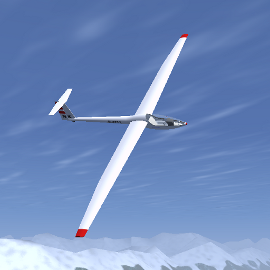Glaser-Dirks DG-101G
 | |
| Type | Glider |
|---|---|
| Author(s) | Nikolaus Kerner |
| FDM | /JSBSim, /JSBSim, /JSBSim, /JSBSim, /JSBSim, /JSBSim, /JSBSim, /JSBSim |
| --aircraft= | dg101g |
| Status | Development (alpha) |
| Download |
|
The DG-101G is a variant of the first sailplane manufactured by Glaser-Dirks. There are in total 4 versions: DG-100, DG-101, DG-100G, DG-101G. The differences are 2-piece canopy (100) vs. 1-piece canopy (101), all moving stabilizer vs. fixed stabilizer (G). All had the same performance.
All the DG-100 variants are standard class (15m) gliders.
Features
FDM
The initial FDM was created with the aeromatic tool from the JSBSIM website. The fine tuning of the FDM was done with data generated with XFLR5, a simulation tool for calculating performance data of aircrafts.
Winch start
This model enables winch start by the "external forces" feature of JSBSIM FDM. Tow release will be done automatically at a certain position relative to the winch or can be done before by pressing W.
- Ctrl-W creates a winch in front of the glider. The tow will be attached automatically.
- w starts the winch.
- W releases the tow (if not allready automatically released).
Aerotowing
This model enables aerotowing by the "external forces" feature of JSBSIM FDM.
- Ctrl-O searches for an AI-object with callsign "dragger".
- o attaches the tow.
- O releases the tow.
Drag robot
There is a drag robot available. This enables aerotowing without another pilot flying the dragger. The robot can be created on any airfield.
- D creates the drag robot.
- d starts the drag robot.
- Ctrl-d read presets from the properties tree.
Be aware, that the drag robot does not automatically connect the tow. So, you can fire up the drag robot and stay on ground with the glider. To connect use the sequence for aerotowing after you have created the drag robot. Then start the robot.
The drag robot now shift with moving air-masses (wind).
The key properties of the drag robot can be accessed and modified via properties tree (sim/glider/dragger/robot/presets/...). The changed properties are used automatically after the drag roboter resets at exit height or manually by the user (key Ctrl-d). Up to now following properties are available (can change in future):
- sim/glider/dragger/robot/presets/glob_min_speed_takeoff_mps defines the take-off speed of the robot
- sim/glider/dragger/robot/presets/glob_max_speed_mps defines the maximum speed of the robot
- sim/glider/dragger/robot/presets/glob_max_speed_lift_mps defines lift at maximum speed of the robot
- sim/glider/dragger/robot/presets/glob_max_speed_tauten_mps defines the max speed over ground for tauten the rope
- sim/glider/dragger/robot/presets/glob_min_acceleration_mpss defines the acceleration in the tauten sequence
- sim/glider/dragger/robot/presets/glob_max_acceleration_mpss defines the acceleration after the tauten sequence
- sim/glider/dragger/robot/presets/glob_max_roll_deg defines the maximum roll angle of the robot
- sim/glider/dragger/robot/presets/glob_max_rollrate_degs defines the maximum roll speed of the robot
- sim/glider/dragger/robot/presets/glob_max_turnrate_degs defines the maximum turn rate at maximum roll angle
- sim/glider/dragger/robot/presets/glob_max_lift_height_m defines the exit height over start point for automatic un-hooking
- sim/glider/dragger/robot/presets/glob_max_tautendist_m defines the distance from starting point for switching from tauten sequence to normal operation
Water ballast
The glider is equiped with water ballast tanks.
- T fills water into the tanks.
- t toggles dumping water.
Speedbrakes
The speedbrakes are connected to the throttle for a smooth operation. The wheel brakes are syncronized with the speedbrakes.
Instrumentation
- ASI: 80mm Winter 6FSM4
- AI: 80mm Winter 4FGH10, with height ring
- VSI: 80mm Winter 5STV5, total energy compensated, with McCready ring,
- VSI: 57mm similar Winter
- compass: 57mm
- radio: 57mm Dittel FSG2T
- turn indicator: 57mm
Development status
Following topics are still in development.
- Yawstring: currently the yawstring is less sensitive (at least visually). To improve the sensitivity a table based amplification will be implemented with the next release.
- Turn indicator: the current turn indicator was used from the first implementation of the DG-101G. An updated model will be used with the next release. There is also an issue with the sensitivity of the ball. The next release will use the same approach as the ASK13.
- Drag robot: the current script is right now more a rough sceleton of the idea of a robot. There are still a lot of issues to solve. The robot does not consider sidewind or headwind, so the true airspeed from robot to glider can differ in any direction. Also the landscape around the airfield is not considered. It is possible, that the robot runs into hills. And ... and ... and ... (still a lot of functionallity missing).
External link
| |||||

